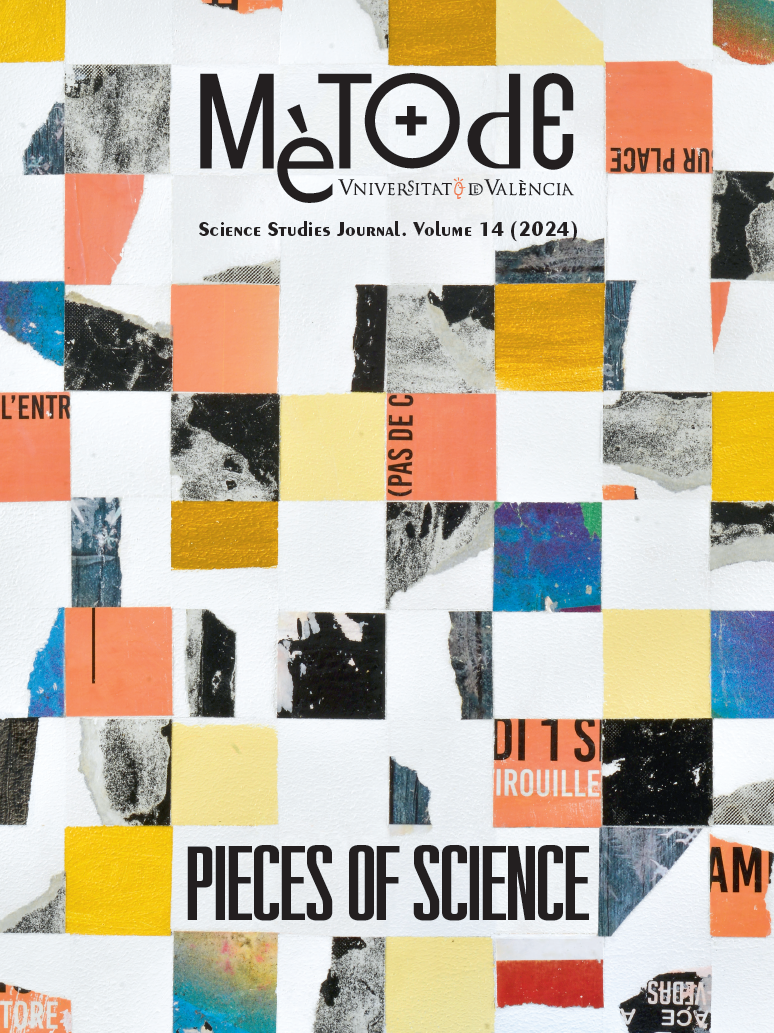Contem la ciència: Una revisió d’idees sobre 'storytelling' en comunicació de ciència
DOI:
https://doi.org/10.7203/metode.14.26522Paraules clau:
storytelling, comunicació de la ciència, narrativa, periodisme científic, emocions Resum
Resum
Dels abundants estudis que existeixen sobre storytelling en la comunicació pública de ciència, la majoria fan seua la premissa que la narrativa és útil. En aquest article resumim els resultats d’una revisió d’idees sobre aquest tema, guiades per una sèrie de preguntes sobre els objectius, tècniques i processos d’investigació. Encara que no trobem consens sobre la definició d’història, sí que identifiquem algunes aproximacions. Són diversos els objectius que persegueix l’ús de storytelling (‘narració’) en la comunicació de ciència, des de captar l’atenció fins a crear emocions que afavorisquen la comprensió. L’estructura de les històries sembla un element crucial, i predominen tres tipus d’estructures. Com a camp en evolució, encara no hi ha molts estudis empírics, però els pocs disponibles semblen prometedors. En conclusió, podem dir que existeix un ampli potencial de debat i investigació sobre les emocions, la persuasió, la comprensió i la innovació en l’ús de conceptes i metodologies per a contar millor la ciència.
 Descàrregues
Descàrregues
 Referències
Referències
Brounéus, F., Lindholm, M., & Bohlin, G. (2019). Telling it straight – a focus group study on narratives affecting public confidence in science. JCOM: Journal of Science Communication, 18(05), A03. https://doi.org/10.22323/2.18050203
Cormick, C. (2019). Who doesn’t love a good story? – What neuroscience tells about how we respond to narratives. JCOM: Journal of Science Communication, 18(05), Y01. https://doi.org/10.22323/2.18050401
Crúz-Mena, J. (2016). El placer de ser contagioso. In D. Golombek & J. Nepote (Coords.), Instrucciones para contagiar la ciencia (pp. 105–111). Editorial Universidad de Guadalajara.
Dahlstrom, M. F. (2010). The role of causality in information acceptance in narratives: An example from science communication. Communication Research, 37(6), 857–875. https://doi.org/10.1177/0093650210362683
Dahlstrom, M. F. (2014). Using narratives and storytelling to communicate science with nonexpert audiences. Proceedings of the National Academy of Sciences of the United States of America, 111(supplement_4), 13614–13620. https://doi.org/10.1073/pnas.1320645111
Dahlstrom, M. F., & Scheufele, D. A. (2018). (Escaping) the paradox of scientific storytelling. PLOS Biology, 16(10), e2006720. https://doi.org/10.1371/journal.pbio.2006720
Davies, S. R., Halpern, M., Horst, M., Kirby, D., & Lewenstein, B. (2019). Science stories as culture: Experience, identity, narrative and emotion in public communication of science. JCOM: Journal of Science Communication, 18(05), A01. https://doi.org/10.22323/2.18050201
ElShafie, S. J. (2018). Making science meaningful for broad audiences through stories. Integrative and Comparative Biology, 58(6), 1213–1223. https://doi.org/10.1093/icb/icy103
Finkler, W., & León, B. (2019). The power of storytelling and video: A visual rhetoric for science communication. JCOM: Journal of Science Communication, 18(05), A02. https://doi.org/10.22323/2.18050202
Green, S., Grorud-Colvert, K., & Mannix, H. (2018). Uniting science and stories: Perspectives on the value of storytelling for communicating science. FACETS, 3(1), 164–173. https://doi.org/10.1139/facets-2016-0079
Halverson, J. R. (2011, 8 December). Why story is not narrative. Center for Strategic Communication. Arizona State University. https://csc.asu.edu/2011/12/08/why-story-is-not-narrative/
Joubert, M., Davis, L., & Metcalfe, J. (2019). Storytelling: The soul of science communication. JCOM: Journal of Science Communication, 18(05), E. https://doi.org/10.22323/2.18050501
Martin, K., Davis, L., & Sandretto, S. (2019). Students as storytellers: Mobile-filmmaking to improve student engagement in school science. JCOM: Journal of Science Communication, 18(05), A04. https://doi.org/10.22323/2.18050204
Martinez-Conde, S., & Macknik, S. L. (2017). Finding the plot in science storytelling in hopes of enhancing science communication. Proceedings of the National Academy of Sciences of the United States of America, 114(31), 8127–8129. https://doi.org/10.1073/pnas.1711790114
Negrete, A., & Lartigue, C. (2010). The science of telling stories: Evaluating science communication via narratives (RIRC method). Journal of Media and Communication Studies, 2(4), 98–110. https://doi.org/10.5897/JMCS.9000080
Onions, C. T., Friedrichsen, G. W. S., & Burchfield, R. W. (1996). The Oxford dictionary of English etymology. Oxford University Press.
Padian, K. (2018). Narrative and “anti-narrative” in science: How scientists tell stories, and don’t. Integrative and Comparative Biology, 58(6), 1224–1234. https://doi.org/10.1093/icb/icy038
Quoteresearch, A. (2017, 27 December). The plural of anecdote is not data – Quote investigator®. https://quoteinvestigator.com/2017/12/27/plural/#f+17637+1+2
Ribó, I. (2019). Prose fiction an introduction to the semiotics of narrative. Open Book Publishers. https://doi.org/10.11647/OBP.0187
Riedlinger, M., Massarani, L., Joubert, M., Baram-Tsabari, A., Entradas, M., & Metcalfe, J. (2019). Telling stories in science communication: Case studies of scholar-practitioner collaboration. JCOM: Journal of Science Communication, 18(05), N01. https://doi.org/10.22323/2.18050801
San Cornelio, G., & Roig Telo, A. (2022). Storytelling, social media and life stories. BiD: Textos Universitaris de Biblioteconomia i Documentació, 48. https://doi.org/10.1344/bid2022.48.14
Vanoost, M. (2013). Defining narrative journalism through the concept of plot. Diegesis, 2(2), 77–97. https://www.diegesis.uni-wuppertal.de
Descàrregues
Publicades
Com citar
-
Resum571
-
PDF 304
Número
Secció
Llicència
![]()
Tots els documents inclosos en OJS són d'accés lliure i propietat dels seus autors.
Els autors que publiquen en aquesta revista estan d'acord amb els següents termes:
- Els autors conserven els drets d'autor i garanteixen a la revista el dret a la primera publicació del treball, llicenciat baix una llicència de Reconeixement-NoComercial-SenseObraDerivada 4.0 Internacional de Creative Commons, que permet a altres compartir el treball amb un reconeixement de l'autoria del treball i citant la publicació inicial en aquesta revista.
- Es permet i s'anima els autors a difondre la versió definitiva dels seus treballs electrònicament a través de pàgines personals i institucionals (repositoris institucionals, pàgines web personals o perfils a xarxes professionals o acadèmiques) una vegada publicat el treball.





